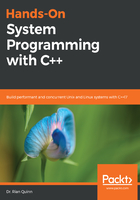
Beginning with the C standard language
The C programming language is one of the oldest languages available. Unlike other higher-level languages, C is similar enough to assembly language programming, while still providing some high-level programming abstractions, that it has become a firm favorite among system, embedded, and kernel-level programmers alike.
Almost every major operating system is rooted in C. In addition, most higher-level languages, including C++, build upon C to provide their higher-level constructs, and therefore still require some of the components of the C standard.
The C standard is a huge standard that is managed by the International Organization for Standardization (ISO). We assume the reader has some basic knowledge of the C standard and how to write C code: http://www.open-std.org/jtc1/sc22/wg14/www/docs/n1256.pdf.
For these reasons, the goal of this section is to discuss some topics that are discussed in lesser detail in other books, as well as portions of the C standard that are relevant to this book and system programming, but are missing from the other chapters.
For additional information on the C programming language and how to write C programs, please see the Further reading section of this chapter.